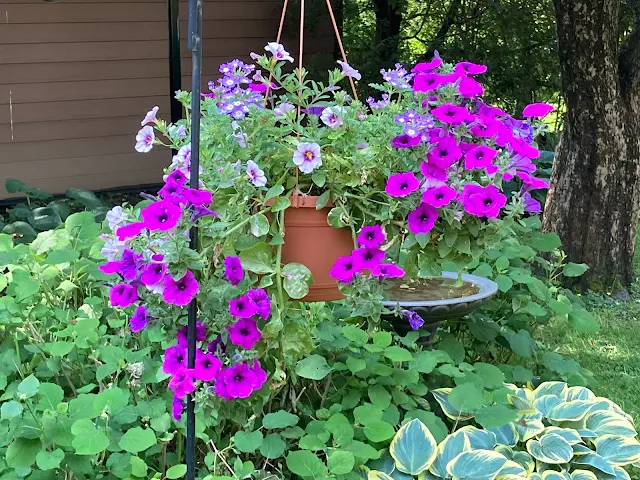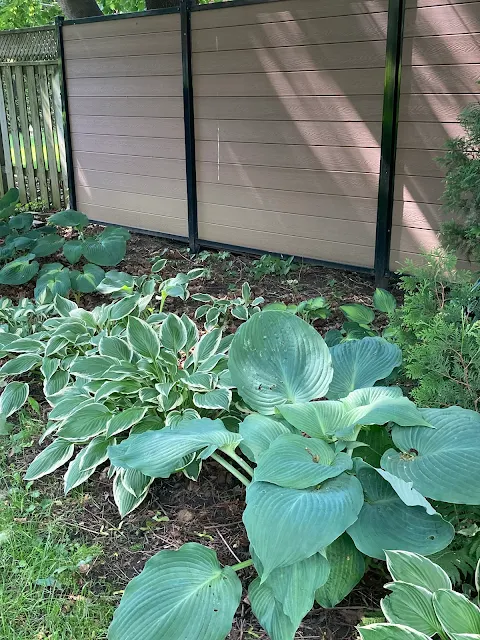This is the best the garden has ever been.
Saturday, August 9, 2025
Thursday, June 12, 2025
The Canadian Cottage Garden, 10 June 2025
An article on the BBC, "Is it better to Neglect Your Garden?”, suggests allowing "nature to take its own course". The whole article is of interest as it suggests the importance of biodiversity, which includes a variety of insects, weeds, and even urban wildlife, and the article goes in some depth on this subject. It even asks, "What if you just do nothing?", and just let one's manicured garden return to nature. This interests me but it would defeat the purpose of my garden; I need to cut the grass, using my push lawn mower, and cut grass allows easy access to the whole garden, especially for seniors, keeps the neighbours and one's family happy, and keeps the gardener busy and getting some exercise. I also need to do some weeding if I want to have as many perennial flowers as I have. To do nothing might reduce the diversity of flowers that I've planted over the years, which is part of a cottage garden; these plants have been cultivated for gardens that are maintained in a traditional way. A return to nature may end up being not having a garden at all; but raking and disposing of leaves in fall can also be limited and even eliminated. The author of the article writes,
While experts recommend doing a little less mowing and pruning in the spring and summer, it's also recommended to let some things pile up in the autumn, specifically leaves. The Xerces Society for Invertebrate Conservation, a non-profit organisation focused on the conservation of invertebrates, promotes an initiative called Leave the Leaves that advocates for this to protect insects that overwinter on your property.
I didn't discard the leaves last fall, I raked them onto flower beds, and, for the most part, they are no longer visible except around the hostas at the rear of the garden. They are excellent mulch and allowed my lavender, and other plants, to survive our particularly cold winter. My own approach to gardening is more aesthetic than anything, as it might be for most gardeners. I would like my own small, shady, garden to be as much a part of nature as possible. I welcome weeds, I welcome as many insects as visit the garden, I rejoice seeing birds, and I celebrate any wildlife that passes through the garden; a garden is a simulated return to nature that allows access for people to enter, sit and visit, or just walk through. An enclosed or walled garden is a private space for nature, usually in an urban setting, the more abandoned looking the better but not, in fact, abandoned at all. Gardening is more artifice than authenticity, as poets might say, although in poetry authenticity is better than artifice; living in the city some of us want to return to nature but just to neglect the garden ends up having an unusable and perhaps uninviting garden, and defeats the purpose of the cottage garden. Here are photographs of my garden taken on 10 June 2025; this is early June in Montreal's West End, still waiting for most perennials to bloom.
Tuesday, April 4, 2023
The garden on April 4th, 2023
It's April 4th today and the snow is still here, but rain is forecast and perhaps by later this week the snow will have melted. Our gardening season is short here, it's from May to October. Winter is from January to the end of March and then overlaps into April, and then it is still cold but at least the snow is melting. May 1st comes suddenly and people begin installing their window air conditioning units; at last we can open the windows and turn off the furnace. Here, we all listen to daily weather forecasts, and we wait for this cold weather to end.
 |
| In the sun the snow has already melted |
 |
| Tulips are already coming up |
 |
| This is a hollyhock coming up |
 |
| In the sun, where plants are protected and the snow has melted, tulips are beginning to grow |
Friday, January 6, 2023
Hortus Conclusus at Le Grand Seminaire
Years ago, I visited Le Grand Seminaire, it is where my great great uncles, Fr. Martin Callaghan and his brother Fr. James Callaghan are buried. It is also where both men were educated in the late 1800s and I've always felt that attending this school was a great opportunity for both men; they were born into the working class, they became priests, educated men, and they served their community. A few years after this first visit I went on a tour of the seminary; it is located on Sherbrooke Street West near Atwater. From the street you can see the twin towers, built in the late 1600s, they were a place of safety when Indigenous people might attack the compound; it was where they would hide in the towers.
 |
| Note the image of Christ at the top left of this image; this hortus conclusus corresponds better to the garden at Le Petite Seminaire in Old Montreal |
On my first visit to Le Grand Seminaire I walked around the grounds; there is a kind of enclosed garden or green space; you can see the stone walls that surround the place below. There is a rectangular pool, see below, that had been neglected. I suspect that access to the grounds is now more difficult as the old seminary has become quite a prestigious private high school.
.jpg) |
Le Grand Seminaire from Sherbrooke Street West.jpg) .jpg) These twin towers can be seen from Sherbrooke Street West  |
 |
| Drawing of Le Grand Seminaire from 1600s |



































.jpg)
.jpg)
.jpg)


.jpg)
.jpg)
.jpg)
.jpg)